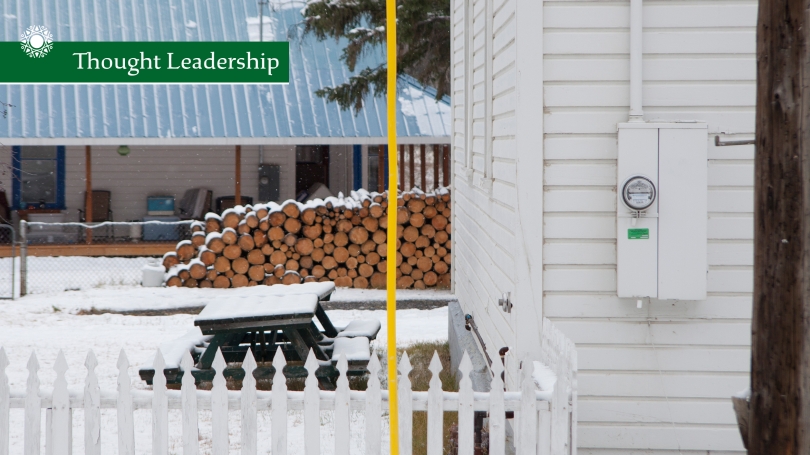

In April 2025, federal staff for the Low Income Home Energy Assistance Program (LIHEAP) were dismissed [1, 10]. While imperfect, LIHEAP provides critical support for a pressing issue affecting the wellbeing of people in every state of the USA: energy insecurity. The Energy Justice Clinic at Dartmouth has been conducting a two-year mixed methods research study with community partners and students on how energy insecurity is lived and experienced in New Hampshire and Vermont. Here we define the problem of energy insecurity and argue that defunding LIHEAP presents an impending crisis.

Every year, over 34 million Americans are forced into impossible trade-offs, such as choosing between food and heating their homes. Energy is a basic human right and a fundamental aspect of daily life that often goes unnoticed until it's suddenly (or chronically) unavailable.
Access to reliable electricity and affordable heating is essential for survival, especially during extreme weather events like heat waves or cold snaps. However, for approximately 10% to 13% of Americans, energy insecurity is a harsh reality [5]. This challenges the misconception that energy access issues are only a problem in developing nations; they are a pressing concern right here in the US.
Energy security means having consistent, reliable access to essential services—heating, cooling, lighting, and powering necessary appliances—without sacrificing other necessities like housing, food, or healthcare. When this security is lacking—what we call energy insecurity—individuals are forced into unmanageable sacrifices.
For example, a community member from New England's Upper Valley shared during our research: "It's cutting back on what I spend money on, like do I spend money on food, or do I spend money on clothing, or pay the electric bill? So, it was either giving up food or paying the electric bill." Such decisions can have significant physical and mental health – and even life-threatening – consequences, especially in regions that experience extreme temperatures.
Economic factors further deepen the crisis. Rising housing and food costs have outpaced income growth, placing a heavier burden on those with fixed incomes–such as retirees and people with disabilities–who struggle to absorb these price hikes. Our research agrees with findings in academic literature that renters are often also unduly burdened by these factors and have less options available to participate in decarbonization than homeowners [7, 12].
The federal Low Income Home Energy Assistance Program (LIHEAP) is the primary safety net for those at risk of energy insecurity. Established in 1981 to help low-income families heat their homes during cold winters, it was expanded in 1984 to include cooling assistance. However, the program has predominantly remained a heating subsidy.
While the funding has fluctuated, in 2023 LIHEAP reached 2.1 million households with disabled members, 1 million households with small children, and 2.4 million households with elderly residents—all groups particularly sensitive to extreme temperatures because they are less able to regulate their body temperature [8].
The urgency is underscored by experts like Diana Hernández, associate professor at Columbia University and co-director of the Energy Opportunity Lab, who emphasizes: "Energy assistance is a last resort. [People] usually go there in a moment of crisis, oftentimes because they are facing a utility disconnection…and disconnections are the crisis point in energy insecurity" [5]. With an annual allocation of about $4 billion, LIHEAP provides essential aid nationwide to those on the brink of crisis.
However, the program's future is under threat. In April 2025, the entire federal LIHEAP staff was dismissed, and if proposed budget cuts proceed, funding could be eliminated entirely [1, 10]. Without adequate support, vulnerable populations risk being left without the means to stay safe as extreme weather conditions intensify [2]. Service providers in New England with whom we have spoken to view this as an imminent crisis.
Leaders nationwide recognize how vital LIHEAP is. Senator Lisa Murkowski of Alaska describes it as a "lifesaver," while Mark Wolfe, director of the National Energy Assistance Directors Association, highlights the stakes of losing LIHEAP: "...we'll be having more and more of these unnecessary deaths" [8].
State officials echo this sentiment. Carter Friend, CEO of Maine's York County Community Action Corporation, affirms, "It is literally a lifesaving program for folks," and Maine Housing Director Dan Brennan also underscored its importance in a state where more 40,000 residents may lack heating support this winter [3].
On May 28th, 2025, Vermont's Congressional delegation—Senators Bernie Sanders and Peter Welch, along with Representative Becca Baltint—jointly urged the Department of Health and Human Services to preserve LIHEAP funding. In their letter, they highlighted that the program is a lifeline for more than 26,000 Vermonters and 6.2 million Americans nationwide [13]. Nearly a quarter of Vermont households reported being unable to fully pay their energy bills in 2024, underscoring the ongoing crisis. They warned that without federal aid, states might be forced to cut critical social services, jeopardizing household stability and community health amidst federal budget cuts.
The consequences of unaffordable energy extend far beyond immediate discomfort—they threaten household stability and can lead to homelessness. When families cannot pay their utility bills, evictions or displacements often follow, placing additional strain on local resources and social safety nets. For example, municipalities like Lebanon, New Hampshire (NH), and organizations such as LISTEN Community Services are already experiencing rising demand for food, heating, and electricity aid—reflecting a broader national trend of increasing energy insecurity.
Rebecca Desilets, Assistant Director of Human Services for the City of Lebanon, NH, shared that "In New Hampshire, each municipality is responsible for ensuring that its residents' basic needs are met." Per NH's Revised Statute 165:1 "Whenever a person in any town is poor and unable to support himself, he shall be relieved and maintained by the overseers of public welfare of such town." Jeanne Robillard, the CEO of NH's Tri-County Community Action, which serves Carroll, Coos, and Grafton Counties, went on to add, "Should LIHEAP as a program be discontinued, it will indeed fall to municipalities to assist households that cannot keep up with energy costs." This means that the loss of federal funding could result in increased municipal taxes.
While LIHEAP serves as a crucial safety net, it is an imperfect program in many respects. Preventive measures—such as investing in energy efficiency and building resilience—could reduce reliance on crisis-driven aid. Furthermore, administrative hurdles limit access to LIHEAP; today, only about 20% of eligible households actually use the program [5].
Despite these limitations, LIHEAP remains essential, especially during extreme weather events when vulnerable households need support the most. Strengthening and expanding its reach, while reducing access barriers, are vital steps toward ensuring energy affordability.
Just as everyone deserves access to clean air and water, affordable energy should be recognized as a fundamental pillar of societal wellbeing. Ensuring energy security through accessible support systems is vital for building resilient, healthy communities. Safety nets like LIHEAP are more critical than ever, especially given three decades of growing income disparity, which makes meeting basic needs increasingly difficult.
Ultimately, safeguarding energy security is about more than just power—it's about fostering stability, equity, and the collective health of society. As President Theodore Roosevelt said, "The welfare of each of us is dependent upon the welfare of all of us."

Sarah Kelly, PhD is a Lecturer in Geography, and Research Scientist and Head of the Energy Justice Clinic at the The Arthur L. Irving Institute for Energy and Society

Derek Walker is the Executive Director of the The Arthur L. Irving Institute for Energy and Society